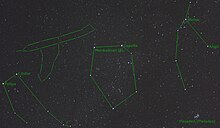
Antlia is a constellation in the Southern Celestial Hemisphere. Its name means "pump" in Latin and Greek; it represents an air pump. Originally Antlia Pneumatica, the constellation was established by Nicolas-Louis de Lacaille in the 18th century. Its non-specific (single-word) name, already in limited use, was preferred by John Herschel then welcomed by the astronomic community which officially accepted this. North of stars forming some of the sails of the ship Argo Navis, Antlia is completely visible from latitudes south of 49 degrees north.

Fornax is a constellation in the southern celestial hemisphere, partly ringed by the celestial river Eridanus. Its name is Latin for furnace. It was named by French astronomer Nicolas Louis de Lacaille in 1756. Fornax is one of the 88 modern constellations.

Microscopium is a minor constellation in the southern celestial hemisphere, one of twelve created in the 18th century by French astronomer Nicolas-Louis de Lacaille and one of several depicting scientific instruments. The name is a Latinised form of the Greek word for microscope. Its stars are faint and hardly visible from most of the non-tropical Northern Hemisphere.

Piscis Austrinus is a constellation in the southern celestial hemisphere. The name is Latin for "the southern fish", in contrast with the larger constellation Pisces, which represents a pair of fish. Before the 20th century, it was also known as Piscis Notius. Piscis Austrinus was one of the 48 constellations listed by the 2nd-century astronomer Ptolemy, and it remains one of the 88 modern constellations. The stars of the modern constellation Grus once formed the "tail" of Piscis Austrinus. In 1597, Petrus Plancius carved out a separate constellation and named it after the crane.
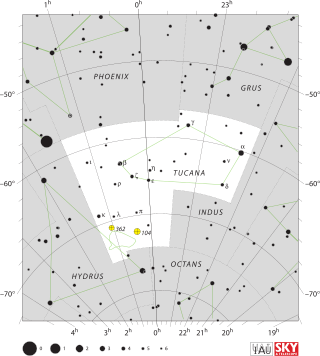
Tucana is a constellation of stars in the southern sky, named after the toucan, a South American bird. It is one of twelve constellations conceived in the late sixteenth century by Petrus Plancius from the observations of Pieter Dirkszoon Keyser and Frederick de Houtman. Tucana first appeared on a 35-centimetre-diameter (14 in) celestial globe published in 1598 in Amsterdam by Plancius and Jodocus Hondius and was depicted in Johann Bayer's star atlas Uranometria of 1603. French explorer and astronomer Nicolas Louis de Lacaille gave its stars Bayer designations in 1756. The constellations Tucana, Grus, Phoenix and Pavo are collectively known as the "Southern Birds".

Telescopium is a minor constellation in the southern celestial hemisphere, one of twelve named in the 18th century by French astronomer Nicolas-Louis de Lacaille and one of several depicting scientific instruments. Its name is a Latinized form of the Greek word for telescope. Telescopium was later much reduced in size by Francis Baily and Benjamin Gould.

Lynx is a constellation named after the animal, usually observed in the Northern Celestial Hemisphere. The constellation was introduced in the late 17th century by Johannes Hevelius. It is a faint constellation, with its brightest stars forming a zigzag line. The orange giant Alpha Lyncis is the brightest star in the constellation, and the semiregular variable star Y Lyncis is a target for amateur astronomers. Six star systems have been found to contain planets. Those of 6 Lyncis and HD 75898 were discovered by the Doppler method; those of XO-2, XO-4, XO-5 and WASP-13 were observed as they passed in front of the host star.
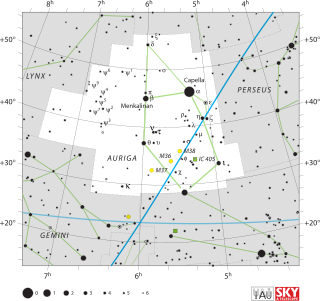
Auriga is a constellation in the northern celestial hemisphere. It is one of the 88 modern constellations; it was among the 48 constellations listed by the 2nd-century astronomer Ptolemy. Its name is Latin for '(the) charioteer', associating it with various mythological beings, including Erichthonius and Myrtilus. Auriga is most prominent during winter evenings in the northern Hemisphere, as are five other constellations that have stars in the Winter Hexagon asterism. Because of its northern declination, Auriga is only visible in its entirety as far south as -34°; for observers farther south it lies partially or fully below the horizon. A large constellation, with an area of 657 square degrees, it is half the size of the largest, Hydra.

Horologium is a constellation of six stars faintly visible in the southern celestial hemisphere. It was first described by the French astronomer Nicolas-Louis de Lacaille in 1756 and visualized by him as a clock with a pendulum and a second hand. In 1922 the constellation was redefined by the International Astronomical Union (IAU) as a region of the celestial sphere containing Lacaille's stars, and has since been an IAU designated constellation. Horologium's associated region is wholly visible to observers south of 23°N.

Lacaille 8760 is a red dwarf star in the constellation Microscopium. It is one of the nearest stars to the Sun at about 12.9 light-years' distance, and the brightest M-class main-sequence star in Earth's night sky, although it is generally too faint to be seen without a telescope. At an apparent magnitude of +6.7, it may only be visible to the unaided eye under exceptionally good viewing conditions, under dark skies.

59 Aurigae, often abbreviated as 59 Aur, is a star in the constellation Auriga. Its baseline apparent magnitude is 6.1, meaning it can just barely be seen with the naked eye as a dim, yellow-white hued star. Based on parallax measurements, it is located about 483 light-years away from the Sun.

Psi2 Aurigae, Latinized from ψ2 Aurigae, is a star in the constellation Auriga. It is faintly visible to the naked eye with an apparent visual magnitude of 4.79. Based upon parallax measurements, this star is approximately 420 light-years away from the Earth. At that distance, the brightness of the star is diminished by 0.07 in magnitude from extinction caused by interstellar gas and dust.

Psi5 Aurigae is a star in the northern constellation of Auriga. It is faintly visible to the naked eye with an apparent visual magnitude of 5.25. Based upon parallax measurements made during the Hipparcos mission, this star is approximately 53.9 light-years distant from Earth. There is an optical companion which is 36 arcseconds away and has an apparent magnitude of +8.4.

V538 Aurigae is a single star in the northern constellation of Auriga. With an apparent visual magnitude of 6.23, this star requires good dark sky conditions to view with the naked eye. It is located at a distance of 40.0 light-years (12.3 pc) from Sun based on parallax. The star is drifting further away with a radial velocity of 0.9 km/s. It is a member of the Local Association, and is most likely a thin disk star.
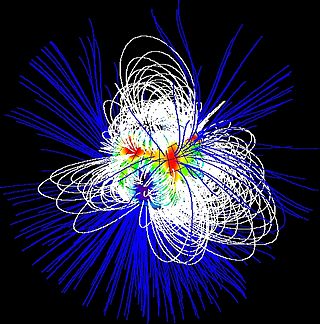
SU Aurigae is a T Tauri-type variable star in the constellation Auriga. It is located about 500 light-years away in the Taurus-Auriga Star Forming Region. Its apparent magnitude is 9.30, which is dim enough that it cannot be seen with the unaided eye.

Mensa is a constellation in the Southern Celestial Hemisphere near the south celestial pole, one of fourteen constellations drawn up in the 18th century by French astronomer Nicolas-Louis de Lacaille. Its name is Latin for table, though it originally commemorated Table Mountain and was known as "Mons Mensae". One of the eighty-eight constellations designated by the International Astronomical Union (IAU), it covers a keystone-shaped wedge of sky 153.5 square degrees in area. Other than the south polar constellation of Octans, it is the most southerly of constellations and is observable only south of the 5th parallel of the Northern Hemisphere.
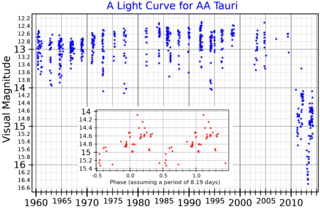
AA Tauri is a young variable star in the equatorial constellation of Taurus, located in the Taurus-Auriga star-forming region. It is too faint to view with the naked eye, having an apparent visual magnitude that varies from 12.2 down to 16.1. The star is located approximately 439 light-years away from the Sun based on parallax, and is drifting further away with a radial velocity of +17 km/s.
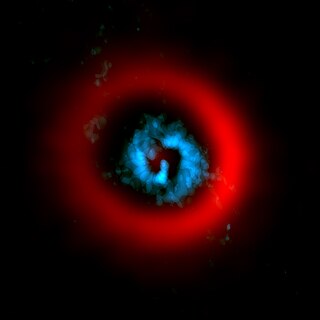
AB Aurigae is a young Herbig Ae star in the Auriga constellation. It is located at a distance of approximately 531 light years from the Sun based on stellar parallax. This pre-main-sequence star has a stellar classification of A0Ve, matching an A-type main-sequence star with emission lines in the spectrum. It has 2.4 times the mass of the Sun and is radiating 38 times the Sun's luminosity from its photosphere at an effective temperature of 9,772 K. The radio emission from the system suggests the presence of a thermal jet originating from the star with a velocity of 300 km s−1. This is causing an estimated mass loss of 1.7×10−8 M☉ yr−1.
Gliese 251, also known as HIP 33226 or HD 265866, is a star located about 18 light years away from the Solar System. Located in the constellation of Gemini, it is the nearest star in this constellation. It is located near the boundary with Auriga, 49 arcminutes away from the bright star Theta Geminorum; due to its apparent magnitude of +9.89 it cannot be observed with the naked eye. The closest star to Gliese 251 is QY Aurigae, which is located 3.5 light years away.

LkCa 15 is a T Tauri star in the Taurus Molecular Cloud. These types of stars are relatively young pre-main-sequence stars that show irregular variations in brightness. It has a mass that is about 97% of the Sun, an effective temperature of 4370 K, and is slightly cooler than the Sun. Its apparent magnitude is 11.91, meaning it is not visible to the naked eye.
